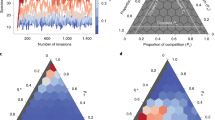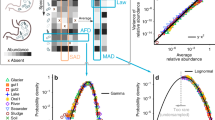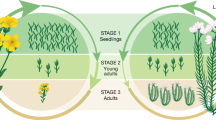Abstract
Priority effects are commonly used to describe a broad suite of phenomena capturing the influence of species arrival order on the diversity, composition and function of ecological communities. Several studies have suggested reframing priority effects around the stabilizing and equalizing concepts of coexistence theory. We show that the only compatible priority effects are those characterized by positive frequency-dependence, irrespective of whether they emerge in equilibrium or non-equilibrium systems.
This is a preview of subscription content, access via your institution
Access options
Access Nature and 54 other Nature Portfolio journals
Get Nature+, our best-value online-access subscription
$29.99 / 30 days
cancel any time
Subscribe to this journal
Receive 12 digital issues and online access to articles
$119.00 per year
only $9.92 per issue
Buy this article
- Purchase on Springer Link
- Instant access to full article PDF
Prices may be subject to local taxes which are calculated during checkout


Similar content being viewed by others
Data availability
All simulated data was generated by R language. All code used for this study is available at https://github.com/pojuke/CoexistPFD and upon request from the corresponding author.
References
Chase, J. M. Oecologia 136, 489–498 (2003).
Fukami, T. Annu. Rev. Ecol. Evol. Syst. 46, 1–23 (2015).
Slatkin, M. Ecology 55, 128–134 (1974).
Lewontin, R. C. Brookhaven Sym. Biol. 22, 13–24 (1969).
May, R. M. Math. Biosci. 12, 59–79 (1971).
Petraitis, P. Multiple Stable States in Natural Ecosystems (Oxford Univ. Press, Oxford, 2013).
Mordecai, E. A. Ecol. Monogr. 81, 429–441 (2011).
Fukami, T., Mordecai, E. A. & Ostling, A. J. Veg. Sci. 27, 655–657 (2016).
Letten, A. D., Ke, P.-J. & Fukami, T. Ecol. Monogr. 87, 161–177 (2017).
Chesson, P. Annu. Rev. Ecol. Syst. 31, 343–366 (2000).
Chesson, P. Theor. Popul. Biol. 37, 26–38 (1990).
Chesson P. & Leemans, R. in Ecological Systems (ed. Leemans, R.) 223–256 (Springer, New York, 2013).
Tilman, D. Resource Competition and Community Structure (Monographs in Population Biology Vol. 17, (Princeton Univ. Press, Princeton, 1982).
Chesson, P. & Kuang, J. J. Nature 456, 235–238 (2008).
Chase, J. & Leibold, M. Ecological Niches: Linking Classical and Contemporary Approaches (Univ. Chicago Press, Chicago, 2003).
Chesson, P. J. Biol. Dynam. 3, 149–163 (2009).
Schreiber, S., Yamamichi, M. & Strauss, S. Preprint at bioRxiv https://doi.org/10.1101/161919 (2017).
Fukami, T. & Nakajima, M. Ecol. Lett. 14, 973–984 (2011).
Soetaert, K., Petzoldt, T. & Setzer, R. W. J. Stat. Softw. 33, 1–25 (2010).
Acknowledgements
We thank T. Fukami, T. Grainger and D. Stouffer for helpful comments. P.-J.K. was supported by Stanford University and the Studying Abroad Scholarship from the Ministry of Education, Taiwan. A.D.L. was supported by a postdoctoral fellowship from the Center for Computational, Evolutionary, and Human Genomics of Stanford University.
Author information
Authors and Affiliations
Contributions
P.-J.K. and A.D.L. conceived the study, performed the analysis and wrote the manuscript.
Corresponding authors
Ethics declarations
Competing interests
The authors declare no competing interests.
Additional information
Publisher’s note: Springer Nature remains neutral with regard to jurisdictional claims in published maps and institutional affiliations.
Supplementary information
Supplementary Information
Supplementary Methods, Supplementary References
Rights and permissions
About this article
Cite this article
Ke, PJ., Letten, A.D. Coexistence theory and the frequency-dependence of priority effects. Nat Ecol Evol 2, 1691–1695 (2018). https://doi.org/10.1038/s41559-018-0679-z
Received:
Accepted:
Published:
Issue Date:
DOI: https://doi.org/10.1038/s41559-018-0679-z
This article is cited by
-
The effect of non-linear competitive interactions on quantifying niche and fitness differences
Theoretical Ecology (2023)
-
Theory of microbial coexistence in promoting soil–plant ecosystem health
Biology and Fertility of Soils (2021)



